Working principle and technical characteristics of aluminum extrusion
1.The important position and role of extrusion in aluminum processing
Extrusion processing occupies a special position in the aluminum alloy industrial system. This is because in recent years, with the continuous progress of science and technology and the rapid development of the national economy, the user departments have put forward new requirements for various quality indicators such as the precision, shape, surface finish and microstructure and properties of aluminum alloy products.
To ensure the supply of aluminum alloy products that meet various quality requirements, the use of extrusion processing technology to produce has greater advantages and advantages than other pressure processing methods (such as rolling, forging, etc.) reliability.
To sum up, extrusion processing has the following incomparable advantages, which occupy an important position and irreplaceable role in aluminum processing:
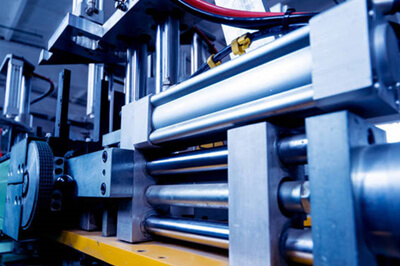
Extrusion machine Shunho Metal solutions
1.1. During the extrusion process, the extruded metal can obtain a more intense and uniform three-dimensional compressive stress state in the deformation zone than rolling and forging, which can fully exert the plasticity of the processed metal itself. Therefore, the extrusion method can be used to process those low-plastic and difficult-to-deform metals or alloys that are difficult or even impossible to process by rolling or forging.
For some materials that must be processed by rolling or forging, such as forgings of 7A04, 7075, 5A06 and other alloys, the ingot is also commonly used to open the ingot by extrusion to improve its structure and plasticity. At present, extrusion is still the most superior method for producing products directly from ingots.
1.2. The extrusion method can not only produce pipes, rods, shapes, and wire products with simple cross-sectional shapes, but also produce profiles and pipes with very complex cross-sections, such as step-change cross-section profiles, gradually-change cross-section profiles, and special-shaped profiles. Integral wall panel profiles of stiffeners, hollow profiles with extremely complex shapes, variable-section pipes, porous pipes, etc.
It is difficult and impossible to produce such products by rolling or other pressure processing methods. Special-shaped integral profiles can simplify complex technological processes, such as cold forming, riveting, welding, cutting, chemical milling, etc., which have great social and economic benefits for reducing equipment investment, saving energy, improving metal utilization, and reducing the total cost of products.
1.3. The extrusion processing is very flexible. It is only necessary to replace the extrusion tools such as molds to produce products of different shapes, specifications and varieties on one equipment. The operation of replacing extrusion tools is simple and easy, less time-consuming and more efficient.
This processing method is the most economical and applicable to aluminum alloy material manufacturing plant with small order batches.
1.4.The precision of extruded products is higher than f hot-rolled and forged products, and the surface quality of the products is also better.
With the improvement of the technological level and the improvement of the quality of the mold, it can now produce a wall thickness of 0.1~0.2mm±0.05mm and a surface roughness of R, up to 0.8~1.8μm ultra-thin, ultra-high-precision, high-quality surface profiles.
This not only greatly reduces the total workload and simplifies the subsequent steps, but also improves the comprehensive utilization rate and yield of extruded metal materials.
1.5. For some aluminum alloys with extrusion effect, the longitudinal strength properties of the extruded products after quenching and aging are much higher than those of similar products processed by other methods. This has practical value for tapping the potential of alloy materials and meeting special requirements.
1.6. The process flow is short, the production and operation are convenient, and the integral structural parts with a larger area than hot die forging or forming rolling can be obtained in one extrusion, and the equipment investment is low, the mold cost is low, and the economic benefit is high.
1.7.Aluminum alloys have good extrusion properties and can be processed by various extrusion processes and various die structures. In recent years, due to the continuous improvement and development of the planar split-flow composite die, the production of complex hollow aluminum products made by the welding extrusion method has been widely used and promoted.
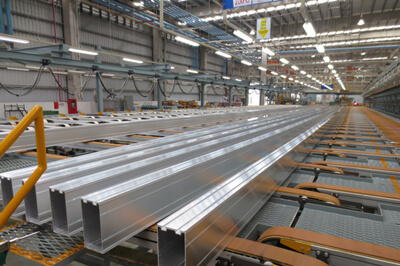
Aluminum profiles on the conveyor belt
Although the extrusion method is used to produce aluminum alloy products, there are still large geometric scrap damage, the extrusion speed is much lower than the rolling speed, the production efficiency is low, the degree of unevenness in structure and properties is large, the extrusion force is large, and the consumption of tooling and die is large. However, with the rapid development of modern technology, the emergence of new extrusion processes, equipment and new structural molds, the above shortcomings are also being being quickly overcome, Especially for aluminum alloys, extrusion processing method is still an advanced processing method to ensure product quality and the best comprehensive benefits.
In the past 30 years, the production capacity of aluminum and aluminum alloy extruded profiles and pipes has continued to grow, and the proportion of extrusion materials in aluminum alloy processed materials has grown rapidly. In 2015, the global aluminum alloy extrusion materials reached About 25 million tons (including about 18 million tons of profiles), accounting for more than 43% of the world's total aluminum.
China is a big country of aluminum extrusion. In 2015, the output of aluminum extrusion products reached 16 million tons, accounting for 57% of the annual aluminum output, becoming the largest product of aluminum processing products in the country.
Aluminum extrusion has a wide range of uses, extending to all industrial sectors and all aspects of people's lives, and has become an important basic material for national economy and social life.
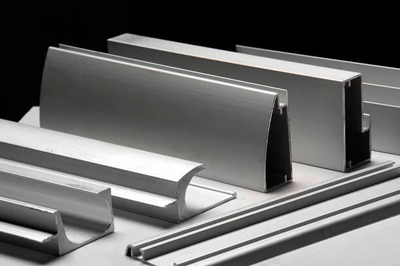
Aluminum profiles for windows, doors
2. The working principle of extrusion and its classification and technical characteristics
The working principle of extrusion and its classification
Extrusion is a processing method that applies an external force to a metal ingot contained in a container (extrusion cylinder) to make it flow out from a specific die hole to obtain the desired cross-sectional shape and size. Compared with forming methods (such as rolling and forging), extrusion methods appeared later.
Around 1797, the Englishman S. Braman designed the world's first mechanical extrusion press for aluminum extrusion. In 1820, British B. Thomas first designed and manufactured a hydraulic lead pipe extrusion machine with the basic components of a modern pipe extrusion machine. Since then, pipe extrusion has developed rapidly.
In 1870, British Hainer invented the reverse extrusion machine for lead pipes. In 1879, the French Borel and the German Wesslau successively developed the lead-coated cable production process, which became the beginning of the world to use the extrusion method to prepare composite materials. Around 1893, British J. Robertso invented the hydrostatic extrusion method, but it was not practical until 1955. In 1903 and 1906, American G.W.Lee applied and published aluminum and copper cold extrusion patents. In 1910, a special aluminum extrusion machine appeared, and the extrusion industry and extrusion technology of aluminum and aluminum alloy materials achieved rapid development.
Since then, scientists and technicians from various countries have successively researched and developed composite billet extrusion, lubricated extrusion, Conform continuous extrusion, isothermal extrusion, water seal extrusion, cooling die extrusion, high-speed extrusion, high-efficiency reverse extrusion, Powder extrusion, semi-solid extrusion, multi-blank extrusion, flat extrusion cylinder extrusion, combined die extrusion, variable section extrusion, fixed gasket extrusion and other extrusion methods and extrusion technologies.
Modern extrusion molding technology has been widely developed and applied in the development and production of aluminum and aluminum alloy materials
According to the stress-strain state of the metal in the extrusion cylinder, the metal flow direction, the lubrication state, the extrusion temperature, the extrusion speed and the structure of the equipment, the type or structure of the tool, the shape or number of the blank, the shape or number of the product Different methods of extrusion molding can be divided into various methods.
These classification methods are not set in stone, and many classification methods can be used as a subdivision of another classification method. For example, forward extrusion and reverse extrusion can be further divided into plane deformation extrusion, axisymmetric deformation extrusion, and general three-dimensional deformation extrusion according to the deformation characteristics.
Several main extrusion methods widely used in the aluminum industry, namely forward extrusion, reverse extrusion, pipe extrusion, continuous extrusion, their main characteristics and working principles are briefly described as follows:
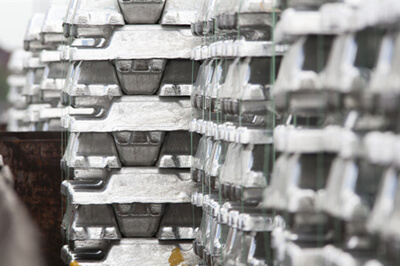
Aluminium ingot
2.1. Direct extrusion (positive extrusion):
During the extrusion process, the extrusion method in which the outflow direction of the product is the same as the movement direction of the extrusion shaft is called positive extrusion. Positive extrusion is the most basic extrusion method. It has become one of the most widely used methods in the forming and processing of aluminum and aluminum alloy materials. direct extrusion can be further subdivided according to other classification methods, such as plane deformation extrusion, axisymmetric deformation extrusion and general three-dimensional deformation extrusion, or divided into cold extrusion, warm extrusion and hot extrusion.
The basic characteristics of direct extrusion are: relative sliding between the billet and the extrusion cylinder during extrusion, there is a large external friction, and in most cases, this friction is harmful, it makes the metal flow unevenly , which will adversely affect the quality of extruded products, resulting in uneven tissue properties of the head and tail, surface layer and center of the extruded product, and it is easy to produce waste products such as coarse crystal ring shrinkage, which increases the energy consumption of extrusion. In general, the frictional energy consumption on the inner surface of the extrusion cylinder accounts for the extrusion energy 30%~40% of the consumption, or even higher; due to the strong frictional heating effect, the improvement of the extrusion speed of low and medium melting point alloys such as aluminum and aluminum alloys is limited, and the wear of the extrusion die is accelerated.
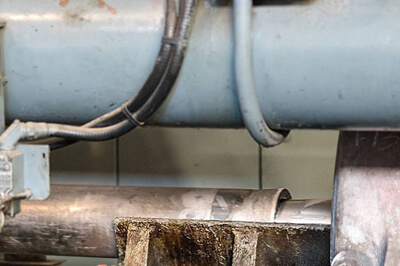
Details of the short trip of the aluminum extruder
2.2. Indirect extrusion:
The extrusion in which the outflow direction of the product is opposite to the movement direction of the extrusion axis during metal extrusion is called reverse extrusion. Hot extrusion of profiles, and cold extrusion of various aluminum alloy parts.
During indirect extrusion, there is no relative sliding between the metal billet and the extrusion cylinder wall, the required extrusion force is small, and the extrusion energy consumption is low. Therefore, on equipment with the same capacity, the reverse extrusion method can achieve a greater degree of deformation. extrusion deformation, or alloys with higher extrusion deformation resistance. The difference between the forward extrusion and reverse extrusion, the metal flow is mainly concentrated in the area near the die hole during the reverse extrusion, so the deformation of the metal along the length of the product is uniform.
However, the operation of indirect extrusion technology is relatively complicated, the gap time is longer than direct extrusion, the surface quality of extruded products is difficult to control, and special extrusion equipment and tools are required, and the application of reverse extrusion is limited to a certain extent. But in recent years, with the successful development of special reverse extrusion machine and the development of tooling and die technology, the reverse extrusion of aluminum alloy has been widely used.
2.3.Conform continuous extrusion:
A common feature of the various methods mentioned above is the discontinuity of extrusion production. A series of auxiliary operations such as separation of excess pressure and filling of blanks are required between the extrusion of the front and rear billets, which affects the efficiency of extrusion production and is not conducive to the extrusion process. Production of continuous long-sized products.
Extrusion production really achieved continuous and obtained better practical application, after D. Green of the British Atomic Energy Agency invented the Conform continuous extrusion method in 1971.The Conform continuous extrusion method uses the friction between the deformed metal and the tool to achieve extrusion. The circular channel formed by the rectangular cross-section groove on the rotating sheave and the fixed die seat plays the role of the extrusion cylinder in the ordinary extrusion method. The billet is fed to achieve continuous extrusion.
During the continuous extrusion of Conform, the friction heating between the billet and the tool surface is relatively significant. Therefore, for aluminum and aluminum alloys with a low melting point, the temperature of the deformation zone can be raised to 400~500 °C without external heating to realize hot extrusion.
Conform continuous extrusion is suitable for the forming of cladding materials such as aluminum-clad steel wires, aluminum and aluminum alloy wires, pipes and profiles with small cross-sectional dimensions. Using expansion die extrusion technology, it can also be used for the production of larger section profiles. In addition, cold extrusion, lubricated extrusion, hydrostatic extrusion and other methods have also been applied in aluminum extrusion.
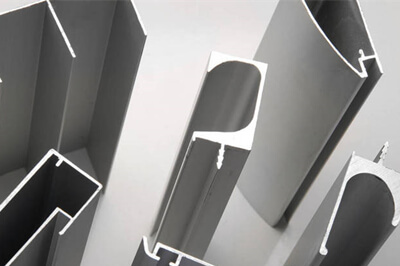
Aluminum extrusion
3.Features of extrusion molding
Extrusion processing has many characteristics, mainly in the stress and strain state of extrusion deformation process, metal flow behavior, comprehensive quality of products, flexibility and diversity of production, production efficiency and cost, etc.
The essential difference between extrusion processing and other primary plastic processing (processing of long products with a certain section) is that it is almost carried out in a closed tool. Therefore, the deformation is done under very high hydrostatic pressure.
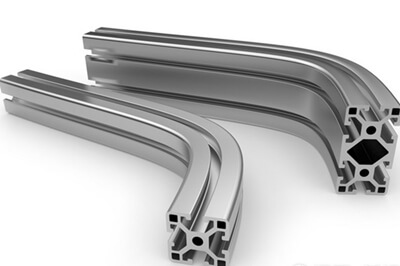
Arc aluminum profile
4.Technical and economical advantages and disadvantages of extrusion processing
4.1.Technical advantages:
Basic characteristics:
The material can be joined at the same time of deformation, and the brittle material can be deformed. Through one process, the cross-sectional shape that is the same as the shape of the mold outlet can be obtained.
Technical features:
It can extrude and join metal powders, metal chips, and dissimilar metals. It can form thin-walled hollow asymmetric products by using a split die. It can also process and form aluminum alloy materials with very low plasticity, and can form cross-sectional shapes. Complex, irregular products can be processed blanks covered with cladding to prevent oxidation and surface cracks.
4.2. Economical advantages:
Basic features:
It can be processed with a large amount of deformation in one process, and the tool is under great pressure; it can deform the coated blank.
Technical characteristics:
As long as one type of mold is changed, the cross-sectional shape of the product can be changed; the number of processes is small, and the area of the factory required is small; the extrusion coefficient of pure aluminum and soft aluminum alloy can reach hundreds, while the hard aluminum alloy is difficult to process The extrusion coefficient can also reach 30~50; continuous casting angle billets can also be used as blanks.
4.3. Economic disadvantages:
The contact time between the tool and the material is long; the contact area between the tool and the material is large; only a blank with a certain volume in the tool can be processed in one process; the shape of the blank section can be freely selected, and the deformation is difficult;
Technical characteristics:
Due to high stress and temperature rise, it is easy to cause mold damage; Due to poor lubrication conditions, it is easy to cause mold wear and tool surface bonding; Due to deformation and frictional heat, it is easy to cause grain growth and surface cracks; Extrusion force increases, energy consumption increases; additional processes such as material loading and unloading are added, resulting in low production speed and low efficiency; due to deformation and temperature instability, the quality of extruded products may not be uniform in the longitudinal direction; Reaching thousands of tons requires a high-power extruder.
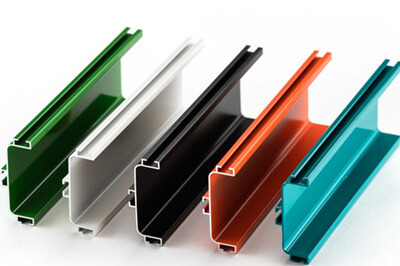
Anodizing for aluminum profiles
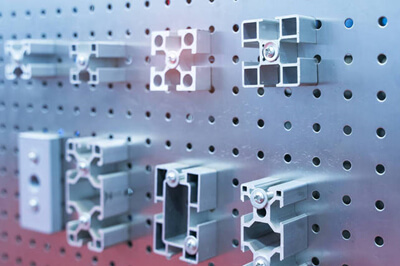
Cross section of the extruded aluminum
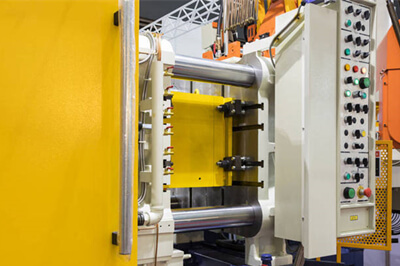
Aluminum high pressure die casting machine












